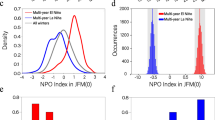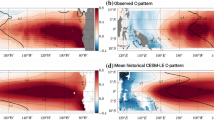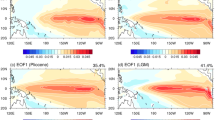Abstract
It has been shown that El Niño events contribute to discharge the warm pool excess of energy out of the tropical Pacific. In a different climate, the energetic budget in the tropical Pacific is altered, which might have an effect on the El Niño amplitude and/or occurrence and thereby on the role of El Niño on energy redistribution. The mid-Holocene period (6 ka BP) offers a good example of changes in the distribution of incoming solar energy. In particular, the equator-pole gradient was weaker compared to the modern period. We analyze long stable simulations of the mid-Holocene and the pre-industrial era and discuss the mean- and El Niño-related energy transports in the two climates. We show that the role of global energy pump played by the tropical Pacific is reduced in the mid-Holocene in our simulation, both in long-term mean and during El Niño years. We demonstrate that this is not only a direct response to insolation forcing but this is further amplified by changes in internal processes. We analyze the relative role of El Niño events in the Pacific discharge in the two climates and show that it is reduced in the mid-Holocene, i.e. the fraction of the Pacific discharge that is due to El Niño is reduced. This is mainly due to reduction in the occurrence of El Niño events. This work gives a new approach to address El Niño changes, from the perspective of the role of El Niño in global energy redistribution.

















Similar content being viewed by others
Notes
Niño3 = 150°W–90°W, 5°N–5°S; Niño3.4 = 170°W–120°W, 5°N–5°S.
It is worth specifying that the results obtained for the MH long-term mean changes in Sect. 4.1 are similar when considering the mean over the entire simulation or over “neutral” years only, i.e. neither selected as El Niño nor as La Niña with the inverse threshold (not shown).
References
An SI, Choi J (2013) Mid-Holocene tropical Pacific climate state, annual cycle, and ENSO in PMIP2 and PMIP3. Clim Dyn. doi:10.1007/s00382-013-1880-z
Bellenger H, Guilyardi E, Leloup J, Lengaigne M, Vialard J (2014) ENSO representation in climate models: from CMIP3 to CMIP5. Clim Dyn 42(7–8):1999–2018. doi:10.1007/s00382-013-1783-z
Berger A (1978) Long-term variations of daily insolation and quaternary climatic changes. J Atmos Sci 35(12):2362–2367. doi:10.1175/1520-0469(1978)035<2362:LTVODI>2.0.CO;2
Bjerknes J (1969) Atmospheric teleconnections from the equatorial pacific1. Mon Weather Rev 97(3):163–172. doi:10.1175/1520-0493(1969)097<0163:ATFTEP>2.3.CO;2
Braconnot P, Kageyama M (2015) Shortwave forcing and feedbacks in last glacial maximum and mid-Holocene PMIP3 simulations. Philos Trans R Soc A 373(2054):20140424. doi:10.1098/rsta.2014.0424
Braconnot P, Marti O, Joussaume S, Leclainche Y (2000) Ocean feedback in response to 6 kyr BP insolation. J Clim 13(9):1537–1553. doi:10.1175/1520-0442(2000)013<1537:OFIRTK>2.0.CO;2
Braconnot P, Marzin C, Grégoire L, Mosquet E, Marti O (2008) Monsoon response to changes in Earth’s orbital parameters: comparisons between simulations of the Eemian and of the Holocene. Clim Past Discuss 4(2):459–493
Braconnot P, Harrison SP, Kageyama M, Bartlein PJ, Masson-Delmotte V, Abe-Ouchi A, Otto-Bliesner B, Zhao Y (2012a) Evaluation of climate models using palaeoclimatic data. Nat Clim Change 2(6):417–424. doi:10.1038/nclimate1456
Braconnot P, Luan Y, Brewer S, Zheng W (2012b) Impact of Earth’s orbit and freshwater fluxes on Holocene climate mean seasonal cycle and ENSO characteristics. Clim Dyn 38(5–6):1081–1092. doi:10.1007/s00382-011-1029-x
Brown J, Tudhope AW, Collins M, McGregor HV (2008) Mid-Holocene ENSO: issues in quantitative model-proxy data comparisons. Paleoceanography. doi:10.1029/2007PA001512
Carré M, Sachs JP, Schauer AJ, Rodríguez WE, Ramos FC (2013) Reconstructing El Niño-Southern Oscillation activity and ocean temperature seasonality from short-lived marine mollusk shells from Peru. Palaeogeogr Palaeoclimatol Palaeoecol 371:45–53. doi:10.1016/j.palaeo.2012.12.014
Clement AC, Seager R, Cane MA (2000) Suppression of El Niño during the Mid-Holocene by changes in the Earth’s orbit. Paleoceanography 15(6):731–737. doi:10.1029/1999PA000466
Cobb KM, Westphal N, Sayani HR, Watson JT, Di Lorenzo E, Cheng H, Edwards RL, Charles CD (2013) Highly variable El Nino-Southern Oscillation throughout the Holocene. Science 339(6115):67–70. doi:10.1126/science.1228246
Dufresne JL, Foujols MA, Denvil S, Caubel A, Marti O, Aumont O, Balkanski Y, Bekki S, Bellenger H, Benshila R, Bony S, Bopp L, Braconnot P, Brockmann P, Cadule P, Cheruy F, Codron F, Cozic A, Cugnet D, Noblet Nd, Duvel JP, Ethé C, Fairhead L, Fichefet T, Flavoni S, Friedlingstein P, Grandpeix JY, Guez L, Guilyardi E, Hauglustaine D, Hourdin F, Idelkadi A, Ghattas J, Joussaume S, Kageyama M, Krinner G, Labetoulle S, Lahellec A, Lefebvre MP, Lefevre F, Levy C, Li ZX, Lloyd J, Lott F, Madec G, Mancip M, Marchand M, Masson S, Meurdesoif Y, Mignot J, Musat I, Parouty S, Polcher J, Rio C, Schulz M, Swingedouw D, Szopa S, Talandier C, Terray P, Viovy N, Vuichard N (2013) Climate change projections using the IPSL-CM5 Earth System Model: from CMIP3 to CMIP5. Clim Dyn 40(9–10):2123–2165. doi:10.1007/s00382-012-1636-1
Duprey N, Lazareth CE, Corrège T, Le Cornec F, Maes C, Pujol N, Madeng-Yogo M, Caquineau S, Soares Derome C, Cabioch G (2012) Early mid-Holocene SST variability and surface-ocean water balance in the southwest Pacific. Paleoceanography. doi:10.1029/2012PA002350
Emile-Geay J, Cobb KM, Carré M, Braconnot P, Leloup J, Zhou Y, Harrison SP, Corrège T, McGregor HV, Collins M, Driscoll R, Elliot M, Schneider B, Tudhope A (2015) Links between tropical Pacific seasonal, interannual and orbital variability during the Holocene. Nat Geosci. doi:10.1038/ngeo2608
Fasullo JT, Trenberth KE (2008) The annual cycle of the energy budget. Part II: meridional structures and poleward transports. J Clim 21(10):2313–2325. doi:10.1175/2007JCLI1936.1
Fichefet T, Maqueda MAM (1997) Sensitivity of a global sea ice model to the treatment of ice thermodynamics and dynamics. J Geophys Res Oceans 102(C6):12,609–12,646. doi:10.1029/97JC00480
Hasegawa T, Hanawa K (2003) Heat content variability related to ENSO events in the Pacific. J Phys Oceanogr 33(2):407–421. doi:10.1175/1520-0485(2003)033<0407:HCVRTE>2.0.CO;2
Hourdin F, Musat I, Bony S, Braconnot P, Codron F, Dufresne JL, Fairhead L, Filiberti MA, Friedlingstein P, Grandpeix JY, Krinner G, LeVan P, Li ZX, Lott F (2006) The LMDZ4 general circulation model: climate performance and sensitivity to parametrized physics with emphasis on tropical convection. Clim Dyn 27(7–8):787–813. doi:10.1007/s00382-006-0158-0
Jin FF (1997) An equatorial ocean recharge paradigm for ENSO. Part I: conceptual model. J Atmos Sci 54(7):811–829. doi:10.1175/1520-0469(1997)054<0811:AEORPF>2.0.CO;2
Joussaume S, Taylor KE, Braconnot P, Mitchell JFB, Kutzbach JE, Harrison SP, Prentice IC, Broccoli AJ, Abe-Ouchi A, Bartlein PJ, Bonfils C, Dong B, Guiot J, Herterich K, Hewitt CD, Jolly D, Kim JW, Kislov A, Kitoh A, Loutre MF, Masson V, McAvaney B, McFarlane N, de Noblet N, Peltier WR, Peterschmitt JY, Pollard D, Rind D, Royer JF, Schlesinger ME, Syktus J, Thompson S, Valdes P, Vettoretti G, Webb RS, Wyputta U (1999) Monsoon changes for 6000 years ago: results of 18 simulations from the Paleoclimate Modeling Intercomparison Project (PMIP). Geophys Res Lett 26(7):859–862. doi:10.1029/1999GL900126
Kageyama M, Braconnot P, Bopp L, Caubel A, Foujols MA, Guilyardi E, Khodri M, Lloyd J, Lombard F, Mariotti V, Marti O, Roy T, Woillez MN (2013) Mid-Holocene and Last Glacial Maximum climate simulations with the IPSL model-part I: comparing IPSL_cm5a to IPSL_cm4. Clim Dyn 40(9–10):2447–2468. doi:10.1007/s00382-012-1488-8
Karamperidou C, Di Nezio PN, Timmermann A, Jin FF, Cobb KM (2015) The response of ENSO flavors to mid-Holocene climate: Implications for proxy interpretation: ENSO flavors in the Mid-Holocene. Paleoceanography 30(5):527–547. doi:10.1002/2014PA002742
Klein SA, Soden BJ, Lau NC (1999) Remote sea surface temperature variations during ENSO: evidence for a tropical atmospheric bridge. J Clim 12(4):917–932. doi:10.1175/1520-0442(1999)012<0917:RSSTVD>2.0.CO;2
Krinner G, Viovy N, de Noblet-Ducoudré N, Ogée J, Polcher J, Friedlingstein P, Ciais P, Sitch S, Prentice IC (2005) A dynamic global vegetation model for studies of the coupled atmosphere–biosphere system. Glob Biogeochem Cycles. doi:10.1029/2003GB002199
Kutzbach JE, Otto-Bliesner BL (1982) The sensitivity of the African-Asian monsoonal climate to orbital parameter changes for 9000 years B.P. in a low-resolution general circulation model. J Atmos Sci 39(6):1177–1188. doi:10.1175/1520-0469(1982)039<1177:TSOTAA>2.0.CO;2
Li L, Wang B, Zhang GJ (2015) The role of moist processes in shortwave radiative feedback during ENSO in the CMIP5 models. J Clim 28(24):9892–9908. doi:10.1175/JCLI-D-15-0276.1
Liu Z (2002) A simple model study of ENSO suppression by external periodic forcing. J Clim 15(9):1088–1098. doi:10.1175/1520-0442(2002)015<1088:ASMSOE>2.0.CO;2
Liu Z, Kutzbach J, Wu L (2000) Modeling climate shift of El Nino variability in the Holocene. Geophys Res Lett 27(15):2265–2268. doi:10.1029/2000GL011452
Luan Y, Braconnot P, Yu Y, Zheng W, Marti O (2012) Early and mid-Holocene climate in the tropical Pacific: seasonal cycle and interannual variability induced by insolation changes. Clim Past 8(3):1093–1108. doi:10.5194/cp-8-1093-2012
Luan Y, Braconnot P, Yu Y, Zheng W (2015) Tropical Pacific mean state and ENSO changes: sensitivity to freshwater flux and remnant ice sheets at 9.5 ka BP. Clim Dyn doi: 10.1007/s00382-015-2467-7
Madec G, Delecluse P, Imbard M, Lévy C (1997) OPA version 8. Ocean General Circulation Model reference manual. Rapp Int, LODYC, France p 200
Mantsis DF, Clement AC, Broccoli AJ, Erb MP (2011) Climate feedbacks in response to changes in obliquity. J Clim 24(11):2830–2845. doi:10.1175/2010JCLI3986.1
Marti O, Braconnot P, Dufresne JL, Bellier J, Benshila R, Bony S, Brockmann P, Cadule P, Caubel A, Codron F, Noblet Nd, Denvil S, Fairhead L, Fichefet T, Foujols MA, Friedlingstein P, Goosse H, Grandpeix JY, Guilyardi E, Hourdin F, Idelkadi A, Kageyama M, Krinner G, Lévy C, Madec G, Mignot J, Musat I, Swingedouw D, Talandier C (2010) Key features of the IPSL ocean atmosphere model and its sensitivity to atmospheric resolution. Clim Dyn 34(1):1–26. doi:10.1007/s00382-009-0640-6
Mayer M, Haimberger L (2012) Poleward atmospheric energy transports and their variability as evaluated from ECMWF reanalysis data. J Clim 25(2):734–752. doi:10.1175/JCLI-D-11-00202.1
Mayer M, Trenberth KE, Haimberger L, Fasullo JT (2013) The response of tropical atmospheric energy budgets to ENSO. J Clim 26(13):4710–4724. doi:10.1175/JCLI-D-12-00681.1
Mayer M, Haimberger L, Balmaseda MA (2014) On the energy exchange between tropical ocean basins related to ENSO. J Clim 27(17):6393–6403. doi:10.1175/JCLI-D-14-00123.1
McGregor HV, Gagan MK (2004) Western Pacific coral delta18o records of anomalous Holocene variability in the El Niño-Southern Oscillation. Geophys Res Lett. doi:10.1029/2004GL019972
McGregor S, Spence P, Schwarzkopf FU, England MH, Santoso A, Kessler WS, Timmermann A, Böning CW (2014) ENSO-driven interhemispheric Pacific mass transports. J Geophys Res Oceans 119(9):6221–6237. doi:10.1002/2014JC010286
Moy CM, Seltzer GO, Rodbell DT, Anderson DM (2002) Variability of El Niño/Southern Oscillation activity at millennial timescales during the Holocene epoch. Nature 420(6912):162–165. doi:10.1038/nature01194
Oort AH, Yienger JJ (1996) Observed interannual variability in the hadley circulation and its connection to ENSO. J Clim 9(11):2751–2767. doi:10.1175/1520-0442(1996)009<2751:OIVITH>2.0.CO;2
Pan A, Liu Q, Liu Z (2005) Periodic forcing and ENSO suppression in the Cane–Zebiak model. J Oceanogr 61(1):109–113. doi:10.1007/s10872-005-0023-5
Sadekov AY, Ganeshram R, Pichevin L, Berdin R, McClymont E, Elderfield H, Tudhope AW (2013) Palaeoclimate reconstructions reveal a strong link between El Nino-Southern Oscillation and Tropical Pacific mean state. Nat Commun. doi:10.1038/ncomms3692
Saint-Lu M, Braconnot P, Leloup J, Lengaigne M, Marti O (2015) Changes in the ENSO/SPCZ relationship from past to future climates. Earth Planet Sci Lett 412:18–24. doi:10.1016/j.epsl.2014.12.033
Taylor KE, Stouffer RJ, Meehl GA (2012) An overview of CMIP5 and the experiment design. Bull Am Meteorol Soc 93(4):485–498. doi:10.1175/BAMS-D-11-00094.1
Trenberth KE, Fasullo JT (2013) An apparent hiatus in global warming? Earth’s Fut 1(1):19–32. doi:10.1002/2013EF000165
Trenberth KE, Stepaniak DP, Caron JM (2002) Interannual variations in the atmospheric heat budget. J Geophys Res Atmos 107(D8):AAC4-1. doi:10.1029/2000JD000297
Tudhope AW, Chilcott CP, McCulloch MT, Cook ER, Chappell J, Ellam RM, Lea DW, Lough JM, Shimmield GB (2001) Variability in the El Niño-Southern Oscillation through a glacial–interglacial cycle. Science 291(5508):1511–1517. doi:10.1126/science.1057969
Valcke S (2006) OASIS3 user guide (prism_2-5). PRISM Supp Initiat Rep 3:64
Wyrtki K (1975) El Niño-the dynamic response of the equatorial Pacific Oceanto atmospheric forcing. J Phys Oceanogr 5(4):572–584. doi:10.1175/1520-0485(1975)005<0572:ENTDRO>2.0.CO;2
Zhao Y, Harrison SP (2011) Mid-Holocene monsoons: a multi-model analysis of the inter-hemispheric differences in the responses to orbital forcing and ocean feedbacks. Clim Dyn 39(6):1457–1487. doi:10.1007/s00382-011-1193-z
Zhao Y, Braconnot P, Marti O, Harrison SP, Hewitt C, Kitoh A, Liu Z, Mikolajewicz U, Otto-Bliesner B, Weber SL (2005) A multi-model analysis of the role of the ocean on the African and Indian monsoon during the mid-Holocene. Clim Dyn 25(7–8):777–800. doi:10.1007/s00382-005-0075-7
Zheng W, Braconnot P, Guilyardi E, Merkel U, Yu Y (2008) ENSO at 6 ka and 21 ka from ocean–atmosphere coupled model simulations. Clim Dyn 30(7–8):745–762. doi:10.1007/s00382-007-0320-3
Acknowledgments
This work was supported by the French ANR Project ELPASO (No. 2010 BLANC 608 01), and by the Knowledge and Innovation Community Climate-KIC from the European Institute of Innovation and Technology (EIT). We acknowledge the World Climate Research Programme’s Working Group on Coupled Modelling, which is responsible for CMIP, and we thank the PMIP3 modelling groups for producing and making available their model output. For CMIP the U.S. Department of Energy’s Program for Climate Model Diagnosis and Intercomparison provides coordinating support and led development of software infrastructure in partnership with the Global Organization for Earth System Science Portals. This study benefited from the IPSL Prodiguer-Ciclad facility which is supported by CNRS, UPMC, Labex L-IPSL which is funded by the ANR (Grant #ANR-10-LABX-0018) and by the European FP7 IS-ENES2 project (Grant #312979). The computing time was provided by GENCI (Grand Equipement National de Calcul Intensif) and the simulations performed on Curie at TGCC (CEA,France). We acknowledge the three anonymous reviewers for their relevant comments, which led to improve the manuscript.
Author information
Authors and Affiliations
Corresponding author
Additional information
This paper is a contribution to the special collection on ENSO Diversity. The special collection aims at improving understanding of the origin, evolution, and impacts of ENSO events that differ in amplitude and spatial patterns, in both observational and modeling contexts, and in the current as well as future climate scenarios. This special collection is coordinated by Antonietta Capotondi, Eric Guilyardi, Ben Kirtman and Sang-Wook Yeh.
Rights and permissions
About this article
Cite this article
Saint-Lu, M., Braconnot, P., Leloup, J. et al. The role of El Niño in the global energy redistribution: a case study in the mid-Holocene. Clim Dyn 52, 7135–7152 (2019). https://doi.org/10.1007/s00382-016-3266-5
Received:
Accepted:
Published:
Issue Date:
DOI: https://doi.org/10.1007/s00382-016-3266-5




